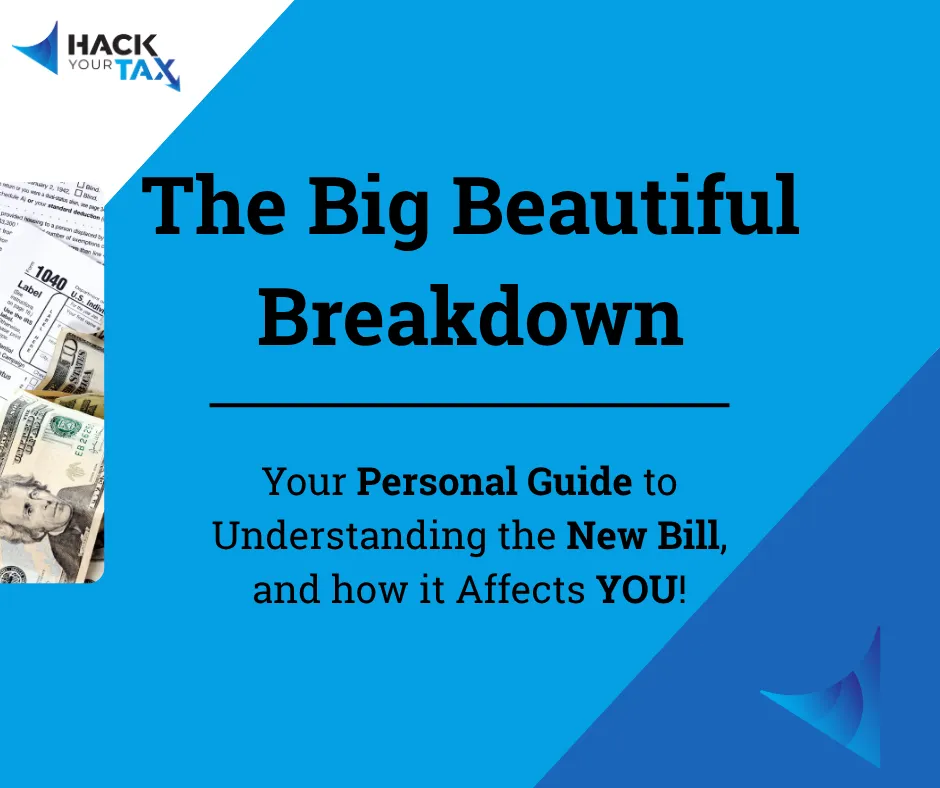
Households | Your Guide to the New Bill
The Big Beautiful Breakdown—How the New Bill Affects Households
The Big Beautiful Bill (OBBB) implements a ton of changes that can be hard to keep up with. This guide is here to help you navigate these changes, and find out what applies to you.
Tax Brackets Stay Permanent
The 7 federal tax brackets (10% to 37%) created under the 2017 Tax Cuts and Jobs Act are now permanent, meaning your tax rate structure isn’t changing anytime soon.
High Standard Deduction Continues
You can still take the larger standard deduction — which simplifies tax filing and reduces taxable income without itemizing:
$15,000 for single filers
$30,000 for married couples filing jointly
Adjusted yearly for inflation
No expiration — this benefit is here to stay.
Child Tax Credit (CTC) Enhanced (Good through 2030)
Parents with children under 17 can now claim:
Up to $2,200 per child
$1,700 of it is refundable (even if you owe no tax)
Income phaseout starts at:
$200,000 (single)
$400,000 (married)
Completely phases out at $240,000 (single) and $440,000 (married)
Children must have Social Security Numbers
Lasts through 2030 unless renewed by Congress.
Example: Marcus, a single dad earning $55,000 with one child, can claim the full $2,200 credit — saving $440 on taxes.
AMT (Alternative Minimum Tax) Relief
Higher income thresholds for the AMT are now permanent, so fewer people will owe this extra tax.
SALT Deduction Cap Raised (2025–2030)
You can now deduct up to $40,000 in state and local taxes (income, property, or sales taxes), up from the old $10,000 cap.
Applies 2025–2030 only
Great for residents in high-tax states like NY, CA, or NJ
Mortgage Interest Deduction Unchanged
You can still deduct interest on up to $750,000 in mortgage debt.
Permanent — no expiration.
Business Loss Limitation is Permanent
Small business owners: the cap on how much you can deduct in business losses is now permanent. If you report losses, you can’t offset unlimited income anymore — so plan carefully.
New Deductions for Workers (2025–2030 Only)
Tip Income Deduction (Section 70201)
Deduct up to $25,000/year in reported cash tips
For employees or independent contractors in tipped industries (servers, barbers, delivery drivers, etc.)
Phases out starting at $150,000 Modified Adjusted Gross Income (MAGI) for single filers
Lasts through 2030
Example: Sarah, a hairstylist, earns $20,000 in tips and deducts it — saving about $3,000 in taxes if she’s in the 15% bracket.
Overtime Pay Deduction (Section 70202)
Deduct up to:
$12,500 (single)
$25,000 (married filing jointly)
Only for W-2 employees (not freelancers or contractors)
Applies to federally mandated overtime pay
Lasts through 2030
Example: James, a nurse who earns $10,000 in overtime, lowers his taxable income to $80,000 and saves about $2,200 in taxes.
Car Loan Interest Deduction (Section 70203)
Deduct up to $10,000/year in interest on loans for new U.S.-assembled personal vehicles
Income limits apply (phaseout starts around $150,000–$200,000 depending on filing status)
Lasts through 2030
Example: Elena buys a new SUV, pays $4,200 in loan interest, and deducts the full amount — saving about $900.
FAQs & Tips
Q: Can I claim the tip deduction without a W-2?
A: Yes — just be sure to report your tips on your tax return.
Q: When does the Child Tax Credit phase out?
A: Entirely phased out at:
$240,000 (single)
$440,000 (married filing jointly)
Tip: Keep records of tips, overtime, and car loan interest — you'll need them to get your full deductions!
Contact us TODAYat https://hackyourtax.com/ to see how you can benefit from tax planning so you can maximize your income!